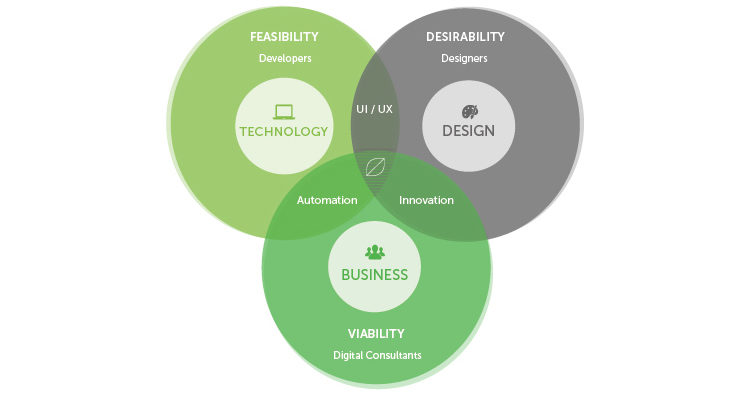Article
Beyond Code: How Fresh’s Software Developers Build Real-World Solutions

For the last three years, a group of Fresh software developers have gathered weekly during lunch on Tuesdays.
They call themselves the Architect Club.
Some members meet in a conference room at Fresh’s Bellevue, Washington home base. Others dial in from cities including San José, Costa Rica and Blumenau, Brazil.
You wouldn’t know the group meets weekly unless you stumbled across the Google Calendar event or received an invite, but not because the Architect Club is exclusive.
To the contrary, they’re welcoming. The only requirement for membership seems to be a desire to join forces with other intelligent people in thinking about how to solve the world’s biggest challenges with technology.
The Architect Club flies under the radar because—at least from this author’s perspective—the defining element of their shared DNA is humility.
They’re a non-boastful bunch committed to solving problems rather than telling the world how great they are. That’s a defining characteristic of Fresh’s software development team as a whole, of which the Architect Club is an extension.
If you’re a non-dev, don’t worry. You’ll feel right at home.
The members of the Architect Club don’t pretend to have every answer to every problem.
They certainly could, and plenty of people in the technology consulting industry do. Together, the group has 100+ years of experience developing amazing software. They’d be justified in kicking up their feet, resting on their laurels, and going about their days on autopilot. But such a laissez-faire approach seems antithetical to their nature.
Sitting in on a meeting, you’ll find that the guiding principles of the Fresh Architect Club—whether written in stone by the group or not—are very straightforward:
- Approach every problem with an open mind about how it can be solved
- Challenge your assumptions while still leveraging your developer’s instincts
- Communicate clearly, describing solutions in a way that non-developers can understand
Solving the world’s logistical challenges via consultative software development
Like every other division at Fresh, the software development team is working hard to help our clients think through challenges in the ports and logistics industry. A few key statistics from NOAA and the EPA show why, in the United States alone, a forward-thinking approach is so vital:
“There are 15,000 miles of waterways, seaports, and other commercially navigable waters in the United States.” – NOAA
The challenge: How do innovators and technologists improve marine environments—and the other pathways they’re connected to—as we streamline the global supply chain?
“American ports are gateways for domestic and international trade. US seaports handle over 99 percent of the country’s overseas cargo by volume and 65 percent by value.” – US EPA
The challenge: How do we optimize these gateways to make them even more effective, more empowered to connect with other ports, and make a national and global impact?
“Our nation’s ports are the lifelines of our economy. Annually, ships move $1.5 trillion in and out of US ports, and ports support more than 13 million jobs.” – NOAA
The challenge: How do we ensure our nation’s lifelines stay healthy, resilient, and future-proof?
But the challenge isn’t confined only to domestic ports. Last November, one of Australia’s major port operators was disrupted by a cyber attack, affecting their ability to manage the “40% of goods entering and leaving the country.” Similar stories abound in other parts of the world.
As such, our team is considering challenges in other countries as well, especially throughout the Latin American region.

Logistics challenges related to fleet and storage management
In the Architect Club’s session we sat in on, Senior DevOps engineer Dagoberto Medina discussed solutions for ports throughout Latin America, focusing on his research about the Puerto Caldera, Costa Rica’s primary port on its Pacific side.
Some of the port’s key challenges include:
- Container Volume Strategy: Managing the volume of containers and ships
- Sea Space Strategy: Limited space to accommodate the ships in the water
- Ship Operations Optimization: Difficulty handling incoming loads, resulting in some ships returning with a portion of their cargo still onboard
Instead of diving into specific technologies, Dagoberto and the Architect Club took a step back and built a hypothesis.
The overarching solution to these common challenges will involve improved cargo logistics optimization and strategy. Given the intermodality of ports, the challenge doesn’t just lie in on-site port infrastructure but also the challenges of road congestion and how that affects the inflow and outflow of products from ports to their final destination or other transport hubs.
The team dove into the more granular elements of the challenge as well:
- Insufficient trucking capacity
- Traffic congestion around the port area
- Limited storage facilities for cargo holding
- The challenge of coordinating schedules between shipping and trucking companies

Enter TruckTrax: a Fresh solution for streamlined fleet management
Over the last several years, Fresh has worked closely with CalPortland, a 130-year-old company that provides building material and construction solutions to the Western United States and Canada.
They came to us to help build TruckTrax, establish software development leadership, implement an agile process, and create a team to rebuild their entire software system. Beyond just making an Android app, ultimately, the project was an effort to bigger picture problems:
- How can we integrate legacy software and leverage the existing infrastructure when writing new code, ensuring “parity plus”?
- While optimizing the technical elements of the platform, how can we also prioritize UX and usability for a non-technical user base?
- Emphasizing the “under the hood” technology, how do we also streamline the UI to help users prioritize essential tasks—users who are driving, multitasking, etc.?
- How do we account for optimizing the database for massive amounts of inbound data from sensors that track concrete drum speed, temperature, and other key factors?
Applied to ports-related challenges, our problem-solving approach with TruckTrax is highly applicable. Some of the biggest challenges for ports (related to Dagoberto’s insights) include digital transformation, optimizing existing infrastructure, ensuring a streamlined user experience for a blue-collar workforce, and handling a massive ingress and egress of data.
The Architect Club is thinking about these critical issues and how to leverage our past project experience to solve the world’s logistical challenges, which presents the opportunity to accelerate critical initiatives for ports in need of timely solutions.

The logistical challenge of on-demand operational insights and analytics
Alvaro Saborio identified additional challenges he’s been researching related to ports in the US and around the globe.
#1 Transportation and Traffic Monitoring: Many ports need help to adopt transportation management software and sensors to monitor vehicle flows in and out of the ports
#2 Cruise and Cargo Forecasting: Demand modeling and capacity planning are also a challenge related to obtaining and processing the vast amount of data that every port deals with
#3 Data Analytics and Connective Systems: Secure systems that connect the diverse community of port authorities, customs, shipping companies, freight forwarders, and government agencies are also a multi-factored challenge
Once again, instead of diving into specific technologies, the Architect Club took a high-level view, diagnosing root causes instead of proposing plans to treat surface-level symptoms.
The team discussed the connective tissue between all of the challenges above:
- The need to optimize timing
- The challenge of routing vehicles during peak periods
- Integrating network data with operations software to improve planning
- Developing highly usable dashboards to help operators forecast and respond

Robot Operational Control: a cross-disciplinary solution for mission planning challenges
Fresh software developers have worked extensively with United Rentals, the world’s largest equipment rental company with a fleet of 4,000+ equipment classes, totaling billions of dollars of original equipment cost.
The $1 trillion construction industry faces diminishing labor forces and an increased need to automate workflows. For the United Rentals engagement, we targeted material delivery to help construction workers and operators manage the delivery routes of formerly manually operated vehicles.
Not only did we help them build autonomous vehicles but also created the platform to help in their operation, addressing critical challenges like a tight labor market, data reporting accuracy, and safety.
Again, the software team—working closely with our robotics engineers—approached the challenge by identifying the underlying challenges before thinking about the technology to solve them:
- How can we “remember the human being,” introducing robust automation functionality while prioritizing usability to give human operators confidence and control over vehicle missions?
- Given the project’s interdisciplinary nature, how can we build an all-in-one app—that combines input from electrical, mechanical, and systems engineers, front- and back-end developers, and UX designers—and ensure that it helps real people solve real-world challenges?
- With an emphasis on firmware and hardware—to ensure these autonomous vehicles function safely and reliably—how can the software team lend its expertise in creating highly reliable, user-friendly applications?
The Robot Operational Control project was a massive success due to treating root causes rather than surface-level symptoms. And thinking about how to apply a similar problem-solving approach to ports- and logistics-related challenges, the parallels are clear.
These hubs of global commerce are facing immense challenges related to monitoring, forecasting, and planning, with trillions of data points to consider. Applications like ROC are helpful across industries. With their well-defined approach to problem-solving, the Architect Club—and Fresh’s software development practice as a whole—is cut out to think about authentically applying similar solutions.
Software developers who solve real-world problems
Isn’t that the ultimate value proposition? A team that digs deep to solve problems at their core, rather than simply creating flashy solutions that fail to hold up?
Problem solving is precisely what the Fresh software development team excels at, with an evolving, adaptive approach spearheaded by the Architect Club. The team can solve challenges in any discipline using technologies like React, Angular, Flutter, Vue.js, and dozens others. But their key differentiator is the ability to apply a practical problem-solving methodology across industries, the value of which is illustrated in every project they’ve worked on.

An online resource hub with a streamlined user experience and easy-to-access tools?
That’s only part of what our software developers provided. Hiring Our Heroes is a tool that provides clear pathways to help veterans and military families define the trajectory of their post-service lives. It’s a resource-rich portal that connects military families to the US Chamber of Commerce’s network of public, private, and nonprofit partners, bridging the civilian-military divide for our nation’s most dedicated servants.

A cross-platform mobile app with a streamlined user flow?
That isn’t the whole story, either. Navia Benefit Solutions helps people find insurance programs easily, a problem which most people can probably identify with. With a benefits platform offering streamlined access to—and understanding of—best-in-class FSA, HSA, HRA, Commuter, Wellness, and COBRA plans, the user flow is more straightforward.

A WordPress website with optimized page speed, SEO, and analytics?
Again, there’s a lot more to it. Our software developers’ work with Caris Life Sciences was driven by the objective of helping them with their goal to revolutionize healthcare and “provide physicians and patients with the highest quality information about their disease – from detecting it early and determining how best to treat it, to developing the next wave of novel therapies.”
The objective isn’t simply building a website. Rather, it’s helping a stellar organization advance its mission of curing diseases with innovative therapies, and that northstar guided the software development team’s approach.
In every project our software developers take on, the technical elements of development are only one piece of the puzzle
What our software developers set out to do—and what the Architect Club discusses every week—is to solve real-world problems using their gift for building high-quality technology solutions.
From advancing the research work of the world’s foremost experts in relationship psychology and helping to solve the ongoing crisis of a fractured human community to promoting diversity and inclusion initiatives, giving people tools to access the right healthcare plans, and enabling wholesalers to stock restaurants and stores across the West Coast more easily, Fresh’s software development team delivers solutions across industries.
A club. A group of passionate software developers. A think tank for innovation in the modern world.
As Fresh continues working in financial, healthcare, product development, and other vital industries, our software development practice—and resident problem solvers who form the Architect Club—will play an integral role in developing innovative solutions.
We can’t wait to see what they come up with next, and we’ll be sure to share the outcomes of their ongoing work.









